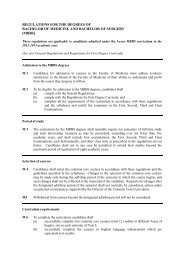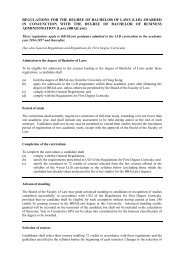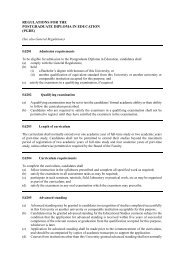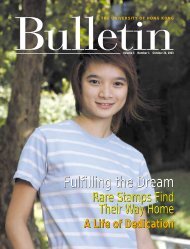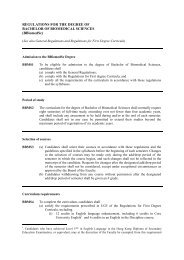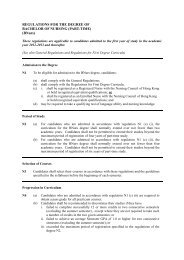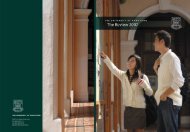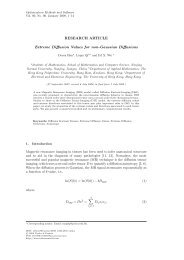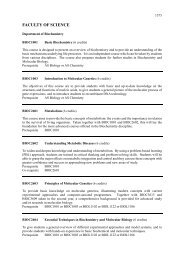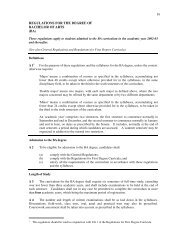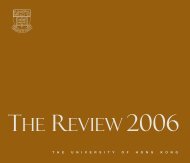Bachelor of Arts (BA) - The University of Hong Kong
Bachelor of Arts (BA) - The University of Hong Kong
Bachelor of Arts (BA) - The University of Hong Kong
Create successful ePaper yourself
Turn your PDF publications into a flip-book with our unique Google optimized e-Paper software.
205HIST2046.<strong>The</strong> modern European city: Urban living and open spaces (6 credits)(This course is also <strong>of</strong>fered to second and third year non-<strong>BA</strong> students for inter-Faculty broadeningpurposes).Over the past century and a half, the majority <strong>of</strong> Europeans have become urban dwellers. On anindividual, civic, national and international level, every aspect <strong>of</strong> social life has been influenced by thisevolution. Consequently, the study <strong>of</strong> cities provides a powerful perspective upon European history. Anessential part <strong>of</strong> the process <strong>of</strong> urbanisation involved the allocation <strong>of</strong> urban open spaces to specificsocial and cultural functions. A key focus for public and private life, the city’s open spaces – parks,gardens, streets and squares – had a fundamental influence upon the nature <strong>of</strong> urban living. As those inpositions <strong>of</strong> power influenced the provision and purpose <strong>of</strong> these areas important developments inEuropean social, economic, cultural and political life were linked closely to the evolution <strong>of</strong> openspaces in cities.In this course the changing use and allocation <strong>of</strong> urban open spaces and the evolution <strong>of</strong> meanings <strong>of</strong>public and private space will provide a lens through which the development <strong>of</strong> modern European citieswill be analysed. <strong>The</strong> importance <strong>of</strong> open spaces will be addressed with recourse to a number <strong>of</strong> keythemes, including the ‘greening’ <strong>of</strong> cities <strong>of</strong> the nineteenth century, the construction <strong>of</strong> ideal Fascist andSocialist cities in the 1930s, functionalism and post-war reconstruction, and the ‘sustainable city’ <strong>of</strong> the1990s. By the end <strong>of</strong> the course the students will not only be more familiar with historical approaches tourban ‘space’ but will also have received an introduction to the evolution <strong>of</strong> European cities and thechanging cultural importance <strong>of</strong> public and private open spaces.Assessment: 100% coursework.SEMINAR COURSES Except for the <strong>The</strong>ory and practice <strong>of</strong> history and the Dissertation elective, theseminar courses listed may not be <strong>of</strong>fered every year. Students should consult the Department to findout which Seminars are to be <strong>of</strong>fered each year.HIST2032. Case studies in women's history: <strong>Hong</strong> <strong>Kong</strong> and the U.S. (6 credits)(Cross-Listing in Department <strong>of</strong> History and Programme in American Studies)(This course is also <strong>of</strong>fered to second and third year non-<strong>BA</strong> students for inter-Faculty broadeningpurposes.)This seminar course will explore themes and issues in women's history/gender history in the 19th and20th century. By focusing on <strong>Hong</strong> <strong>Kong</strong> and the U.S., students will work within a comparativeframework to explore difference and common ground between societies and selected historical periods.Topics include: varieties <strong>of</strong> women's reform movements, gender and World War II, and gender andeconomic transformation in the late 20th century.(Note: <strong>BA</strong>II students wishing to take this course may do so with the permission <strong>of</strong> the Department <strong>of</strong>History or Programme in American Studies.)Assessment: 100% coursework.HIST2045.Shanghai Grand: History, culture and society in urban China (6 credits)(This course is also <strong>of</strong>fered to second and third year non-<strong>BA</strong> students for inter-Faculty broadeningpurposes.)In the first half <strong>of</strong> the twentieth century what did it mean to be both modern and Chinese? To Chineseand foreigners alike, Shanghai represented the most progressive city in China. <strong>The</strong> transformation <strong>of</strong>Shanghai into a world city will be the focus <strong>of</strong> this course. In the process, Shanghai became the site forand the sight <strong>of</strong> contending ideas <strong>of</strong> modernity for a revolutionary generation <strong>of</strong> Chinese determined tobuild a new identity and a new nation.Assessment: 100% coursework.



